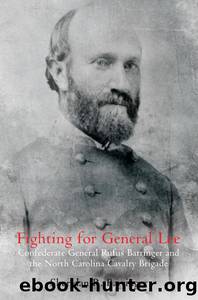Fighting for General Lee by Sheridan R. Barringer

Author:Sheridan R. Barringer [Barringer, Sheridan R.]
Language: eng
Format: epub
Tags: Biography & Autobiography, Military, History, United States, Civil War Period (1850-1877)
ISBN: 9781611213850
Google: 4tukAQAACAAJ
Publisher: Savas Beatie
Published: 2023-04-15T00:39:42+00:00
Brigadier General James Byron Gordon (1822-1864) commanded the North Carolina Cavalry Brigade. He was one of the finest cavalry commanders of the war. Gordon was mortally wounded at Brook Church near Meadow Bridge, north of Richmond on May 12, 1864. North Carolina Division of Archives and History
After the fight at Meadow Bridge, about 400 troopers of the 1st, 2nd, and 5th North Carolina Cavalryâalong with 800 from Wickhamâs brigade, 750 from Lomaxâs, and a number of the 5th South Carolinaâwere engaged in an ill-fated action on May 24. Major General Braxton Bragg requested that Fitz Leeâs cavalry attack Union Brig. Gen. Edward A. Wildâs African American infantry at a fortified outpost called Wilsonâs Wharf, south of City Point on the James River. After an all-night march of 25 miles from Atleeâs Station, Fitz Lee and his horsemen confronted the fort and found it to be stronger than expected. Federal gunboats fired upon Leeâs cavalry, the shells bursting overhead with terrifying impact. Lee attacked the fort anyway, but lived to regret the decision. The 1,800-man Federal position was too strong to overcome. After further reconnaissance, Lee called off the mission and the Confederate horsemen headed back to Atleeâs Station. His casualties numbered about 50 men, including 20 dead.22
Seeking to outflank the Confederates to the east, Grantâs army planned to cross the Pamunkey River near Hanovertown Ferry on May 28, screened by Sheridanâs cavalry. On May 27, David Greggâs cavalry division, supported by Alfred Torbertâs, crossed the Pamunkey and pushed rapidly toward the small village of Hanovertown. The Federal horsemen ran into Gordonâs North Carolina brigade, commanded by Col. John A. Baker. For a time, the Carolinians held their ground, but the overwhelming numbers of Federal cavalry forced them to withdraw toward Hanover Court House. Sheridanâs troopers pressed closely, and captured more than 70 prisoners before halting their pursuit.23
On May 31, Wilsonâs Union troopers ran into pickets of the North Carolina Cavalry Brigade near Hanover Court House. The Carolinians attacked the advancing Federal column and drove them back into their main force. Nearly the entire brigade was dismounted. Later in the day, the Union horsemen made a frontal assault while hitting both flanks of the Rebel troopers. The Carolinians were overwhelmed and retreated south of Hanover Court House to reform their lines. Exhausted and nearly out of ammunition, both sides halted for the night.24
The next day at Ashland, the 2nd North Carolina Cavalry relieved the 1st. With the 5th North Carolina, they drove Wilsonâs Union troopers back about one mile. Thomas L. Rosserâs horsemen, with part of Rooney Leeâs division, attacked the Federal rear and captured numerous prisoners and horses. However, the victory was a costly one. The North Carolina Cavalry Brigade lost another temporary commander. The dashing Brig. Gen. Pierce Young was severely wounded, and Colonel Baker again assumed temporary command of the brigade.25
Barringer recalled that all of these recent fights occurred in thickly wooded areas, where troopers often dismounted and fought with carbines. He remembered: â[A]s the war advanced, the
Download
This site does not store any files on its server. We only index and link to content provided by other sites. Please contact the content providers to delete copyright contents if any and email us, we'll remove relevant links or contents immediately.
Fanny Burney by Claire Harman(26260)
Empire of the Sikhs by Patwant Singh(22775)
Out of India by Michael Foss(16695)
Leonardo da Vinci by Walter Isaacson(12820)
Small Great Things by Jodi Picoult(6694)
The Six Wives Of Henry VIII (WOMEN IN HISTORY) by Fraser Antonia(5246)
The Wind in My Hair by Masih Alinejad(4853)
The Crown by Robert Lacey(4579)
The Lonely City by Olivia Laing(4577)
A Higher Loyalty: Truth, Lies, and Leadership by James Comey(4567)
The Iron Duke by The Iron Duke(4128)
Millionaire: The Philanderer, Gambler, and Duelist Who Invented Modern Finance by Janet Gleeson(4117)
Papillon (English) by Henri Charrière(3924)
Sticky Fingers by Joe Hagan(3917)
Joan of Arc by Mary Gordon(3797)
Alive: The Story of the Andes Survivors by Piers Paul Read(3743)
Stalin by Stephen Kotkin(3731)
Aleister Crowley: The Biography by Tobias Churton(3435)
Ants Among Elephants by Sujatha Gidla(3282)
